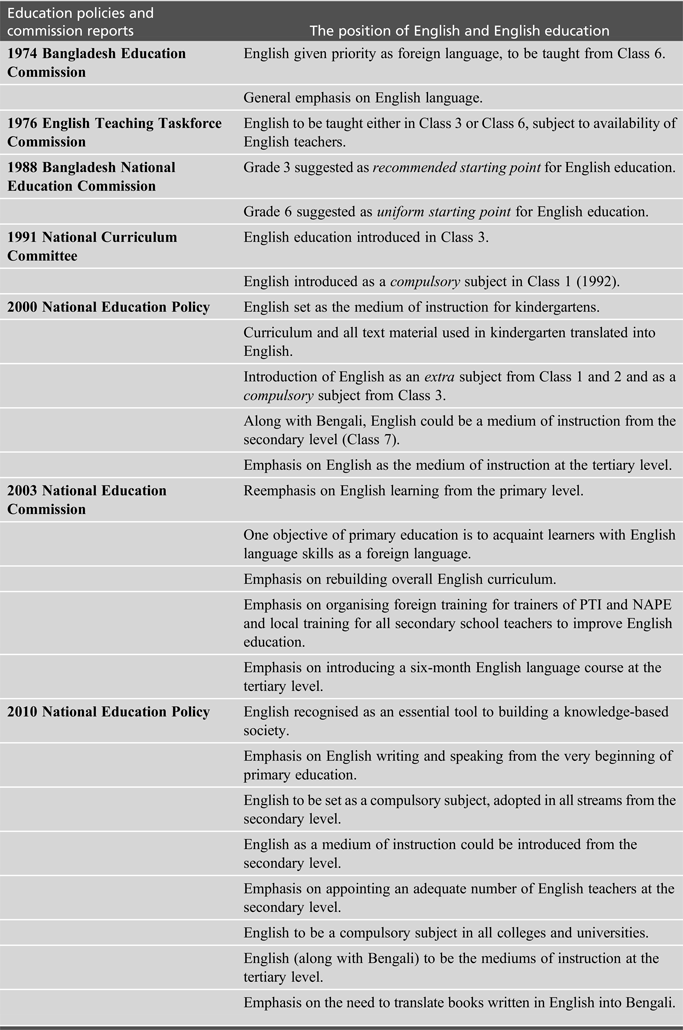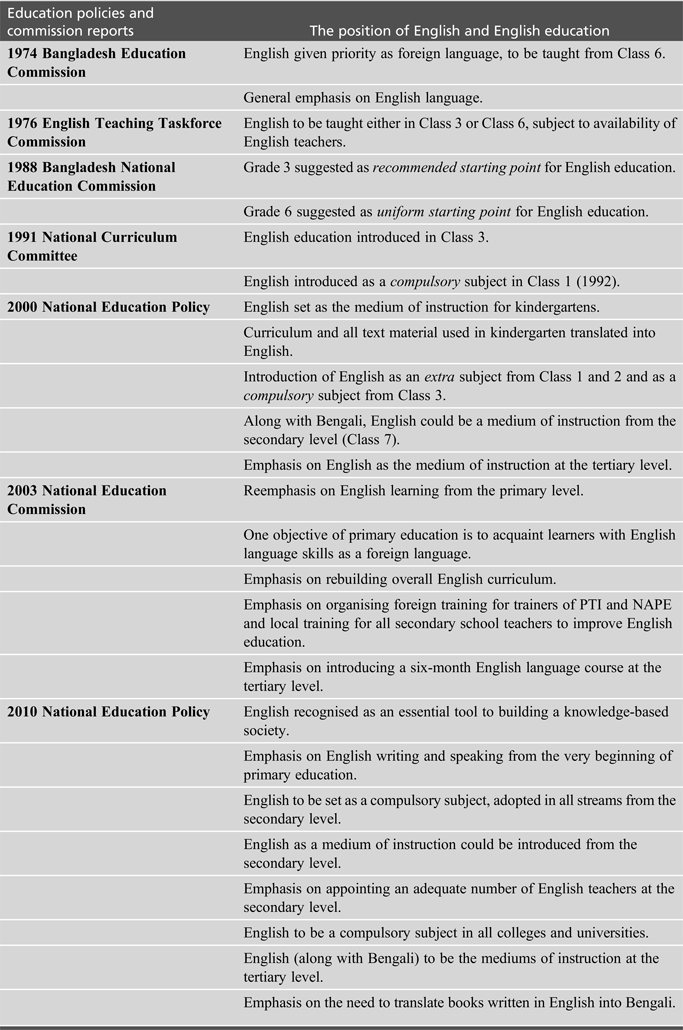Introduction
The 2016 World Bank report on worldwide per capita Gross Domestic Product (GDP) identified Bangladesh as a lower middle-income country based on its consistent GDP growth throughout last decade (World Bank, 2016). To maintain this growth rate and meet the radical demand for human resources in increasingly globalised world markets, the country needs to communicate more effectively with the outside world. Inevitably, this means improving the quality of English teaching and learning. The significance of English, as the global lingua franca, to Bangladeshi learners is at its zenith. In this developing country, however, economic constraints mean that funds allocated to education are limited compared to many other Southeast Asian countries (Habib & Adhikary, Reference Habib and Adhikary2016). Even given the generally low level of educational standards in Bangladesh (Islam, Reference Islam2015), the standard of English language teaching and learning has decreased alarmingly in recent years (Hamid, Reference Hamid, Fishman and Garcia2011). English language education in Bangladesh has always been problematic, despite various attempts to initiate curriculum reform. As Hamid & Baldauf (Reference Hamid and Baldauf2008) point out, the first of these major shifts in the ELT curriculum took place in the mid-1990s, when the traditional Grammar-Translation Method (GTM) was replaced with a curriculum based on a Communicative Language Teaching (CLT) model. The principal objective of this article is to review the major problems associated with ELT in Bangladesh that have hindered the implementation of the new CLT curriculum from the perspective of teachers, and eventually to make recommendations for more effective ELT curriculum reform.
Methodology
This paper is a review based on secondary data. Extensive literature has been reviewed, including searches for peer-reviewed articles from ERIC (EBSCO or CSA) and Google Scholar based on keywords e.g., ELT in Bangladesh, CLT, curriculum implementation, teacher education, etc. All data from different secondary sources are acknowledged.
English Language in Education Policy and introduction of CLT in the curriculum
According to Hamid & Honan (Reference Hamid and Honan2012: 141), ‘[w]ith over 17 million children learning English, Bangladesh is one of the largest populations in the world learning English as a foreign or second language’. One issue is that the form of ELT in Bangladesh – English as a Second Language (ESL) or English as a Foreign Language (EFL) – is a matter of debate among researchers. According to Carter & Nunan (Reference Carter and Nunan2001), ESL refers to where English is widely used in public places and parliament, such as in India, along with the Indian state languages, or in Malaysia. EFL, on the other hand, implies use of English as a foreign language mostly confined to classrooms, and is used mainly for academic purposes, for example China or Pakistan where English is used as a medium of instruction and is not widely used in the community. McArthur (Reference McArthur1996) positions Bangladesh as ESL, but says that use of English is between a second and foreign language in the community. English is the only recognised language in Bangladesh other than Bangla, thus Ali (Reference Ali2010) locates ELT in Bangladesh as ESL, although Ali & Walker (Reference Ali and Walker2014) maintain that English language teaching in Bangladesh is EFL. Most recently, however, the government of Bangladesh mandates English as a second language through its curriculum (Ministry of Education, 2010).
In short, Bangladeshi ELT policy has always been driven by a basic uncertainty and lack of clear vision as to the fundamental status of English in the country. Indeed, according to Chowdhury & Kabir (Reference Chowdhury and Kabir2014), until the National Education Policy (Ministry of Education, 2010), Bangladesh never had any planned and consistent English language policy at all. This problem has been exacerbated by the fact that there are three educational systems in Bangladesh: the ‘mainstream’ secular state education system; the ‘Madrasah’ system of religious education; and ‘English-medium education’ run by the University of Cambridge through the British Council. The role of English language is different in these three systems (Ali & Walker, Reference Ali and Walker2014). In tertiary-level education Bangla and English are the medium of instruction in government schools, but in private universities the medium of instruction is English, and English is also widely used for official purposes (Hamid, Jahan & Islam, Reference Hamid, Jahan and Islam2013)
Before the partition of the Indian subcontinent in 1947, English was the medium of communication with the British and medium of instruction in higher education. However, in 1835, the bureaucratically inspired and culturally patronising Lord Macaulay approved British colonisers to offer English education with the motive of creating a class of faithful Indian administrators in the image of British taste and attitude (Chowdhury & Kabir, Reference Chowdhury and Kabir2014). After division of the subcontinent in 1947, and inspired by religious ideology, Pakistan reassessed and rearranged the English language in education policy and redirected the curriculum with Islamic religious doctrine (Rahman et al., Reference Rahman, Hamzah, Meerah and Rahman2010). However, British and Pakistani rulers held the same political motives and gave English status in education policy on the basis of need.
Soon after the liberation of the country, Bangla became the national language (Banu & Sussex, Reference Banu, Sussex and Moore2001) and ‘official language’ for both communication and instruction in all state academic institutions by an amendment to the constitution in 1972 (Rahman, Reference Rahman2010). After independence, eight education commissions developed blueprints for education policy – the Education Commission Report (1974), the English Teaching Taskforce Commission (1976), the Bangladesh National Education Commission Report (1988), the National Curriculum Committee (1991), the National Education Policy (2000), the Bari Commission Report (2002), the Miah Commission Report (2004), and the National Education Policy (2010). Nevertheless, the status of English has been inconsistent all the way from the first to the last of these reports. These changes have been sketched by Chowdhury & Kabir (Reference Chowdhury and Kabir2014), and are reproduced in Table 1.
Table 1: Chronological summary of English in Education Policy (Chowdhury & Kabir, Reference Chowdhury and Kabir2014: 10)

Inconsistency in education policies has always been a feature of ELT in Bangladesh. Decisions about changes have often been driven by no apparent justification. One such shift in the curriculum was made from traditional GTM to CLT in 1996. Realising the need for communication in English language teaching, in 1996 the Ministry of Education (MoE) moved to a Communicative Language Teaching (CLT) approach in the curriculum (Rahman, Reference Rahman2015), maintaining that CLT is considered useful to develop learners’ communicative skills (Littlewood, Reference Littlewood2007). During the change to introduce CLT to the curriculum, new syllabi, CLT-based materials, and training were needed (Ali & Walker, Reference Ali and Walker2014).
ELT in Bangladesh: Problems hindering the implementation of a CLT Curriculum
The ELT curriculum in Bangladesh in primary, secondary, and higher secondary levels is idealised, developed, and circulated by the National Curriculum and Textbook (NCTB), a wing under the MoE. In a centrally-based education system such as in Bangladesh, where teachers implement products from curriculum developers, there are bound to be problems with a new curriculum; in particular, teachers fail with the curriculum because they do not have a clear idea what is expected of them (Karim, Reference Karim2004). As a consequence, ELT in Bangladesh faces problems implementing the curriculum in the classroom. Two main problem areas will be identified in the following discussion. The first relates to the way in which the needs of the teachers implementing the curriculum reforms have been neglected, and the second relates to the more general lack of teacher training infrastructure in Bangladesh. Each of these will now be discussed in turn.
The Unheard Voice of English Teachers in Bangladesh
Curriculum changes often fail because policy makers do not realise the needs of teachers (Fullan, Reference Fullan2007). In Bangladesh, the reality of the classroom has certainly been ignored. There seems to be no collaboration during different phases of curriculum development in Bangladesh, and so the voice of teachers is unheard (Ali, Reference Ali2010). Part of the problem is that the CLT curriculum was never explained clearly to teachers, with the result that diverse opinions circulated about how to follow a CLT curriculum (Das et al., Reference Das, Shaheen, Shrestha, Rahman and Khan2014). Equally important, however, is the fact that CLT requires teachers to adopt not only an imported Westernised method, but also an entirely different culture of teaching and learning. Teachers in Bangladesh are accustomed to a teacher-centred approach, with fewer student activities and a more formal and less friendly relationship between teachers and students, all of which inhibit CLT curriculum implementation (Yasmin, Reference Yasmin2009). It is therefore not surprising to note that teachers quickly returned to their old ‘chalk-and-talk drill method’ (Littlewood, Reference Littlewood2007: 24; Chowdhury & Ha, Reference Chowdhury and Ha2008), and that GTM continues to have a substantial washback effect on teachers’ classroom practices (Khan, Reference Khan, Moon and Spolsky2010) and thus stubbornly remains the de facto norm for ELT classrooms in Bangladesh. As Abedin (Reference Abedin2012) notes, the method employed by most English teachers in the classroom is not CLT at all in reality, but is instead a disguised version of the GTM that they have always used in the past.
As both Fullan (Reference Fullan2007) and Marsh & Willis (Reference Marsh and Willis2007) have argued, the frequent incompatibility of curriculum innovations with the existing perceptions, beliefs, and values of the teachers charged with implementing these innovations is perhaps the single biggest constraint in curriculum change. The Bangladeshi experience over the last two decades is no exception to this. Since its introduction, and despite constant efforts by policy makers and curriculum developers, the contributions of CLT to English language learning in Bangladesh have been questioned by a growing number of researchers (e.g. Chowdhury & Ha, Reference Chowdhury and Ha2008; Abedin, Mojlis & Akhter, Reference Abedin, Mojlis and Akter2009; Kirkwood & Rae, Reference Kirkwood and Rae2011; Hamid & Honan, Reference Hamid and Honan2012; Ali & Walker, Reference Ali and Walker2014; Rahman, Reference Rahman2015). It should be noted, however, that this experience is not unique to Bangladesh; on the contrary, the effectiveness of CLT around the globe has been questioned by a number of scholars (e.g. Canagarajah, Reference Canagarajah2005; Kumaravadivelu, Reference Kumaravadivelu2001; Nunan, Reference Nunan2003; Humphries & Burns, Reference Humphries and Burns2015). In second language research, findings obtained in one country are not necessarily transferrable to language pedagogy or policy making in another country (Ellis, Reference Ellis2010; Rahman & Pandian, Reference Rahman and Pandian2016), and it is now increasingly recognized that policy makers cannot import and adapt any language teaching approach from the West without considering contextual constraints (Humphries & Burns, Reference Humphries and Burns2015). Unfortunately, policymakers in Bangladesh do not seem to be aware of this as yet.
Teacher Education and Quality of English Teachers
The other major barrier to the effective implementation of a CLT curriculum in Bangladesh is the quality of teachers. Traditionally teacher quality has been associated with their education, experience, and professional support (Stockwell, Reference Stockwell2015). This key issue was identified in the early days of CLT introduction by Selim and Mahboob (Reference Selim, Mahboob, Alam, Zaman and Ahmed2001) and teacher qualifications were exposed as a critical issue in the failure of CLT in ELT in Bangladesh. Kirkwood & Rae (Reference Kirkwood and Rae2011) identify primary and secondary English language teacher qualifications, a good tertiary education, and competency to practice a CLT curriculum in the classroom as pre-requisites for successful ELT curriculum reform. Unfortunately, all of these are currently lacking in Bangladesh. Siddique (Reference Siddique2004) has pinpointed the lack of language proficiency and knowledge of language teaching as a constraint in the use CLT methodology in the classroom, while Sultana and Nahar (Reference Sultana and Nahar2008) have diagnosed similar problems in terms of teacher proficiency. Only a few teachers have received CLT training in selected schools (Islam, Reference Islam2015), and teachers lack resources such as professional journals, periodicals, and training materials (Hoque, Alam & Abdullah Reference Hoque, Alam and Abdullah2011). Rahman, Kobir and Afroze (Reference Rahman, Kobir and Afroze2006) also question the effectiveness of existing training and its poor outcomes. They found that even when teachers have attended numerous training opportunities, their classroom practices have not changed significantly.
Whilst weak dissemination of the curriculum and lack of in-service teacher training or professional development have negatively affected the implementation of the curriculum across the country (Wang & Cheng, Reference Wang and Cheng2008), schools in peripheral areas of Bangladesh face the most serious teacher quality problems. Hamid & Baldauf (Reference Hamid and Baldauf2008) suggest that many ELT practitioners in these areas simply do not have the required ELT qualifications at all. At best, some have a post-graduate level of education in English literature, which is of rather limited usefulness for language teaching.
The traditional approach to teacher professional development tends toward training to provide the necessary skills to teach students (Richards, Reference Richards2008). Initially, CLT was implemented provisionally only in secondary schools. During 1990–1995, OSSTTEB (Orientation to Secondary School Teachers for Teaching of English in Bangladesh), a UK-based donor, funded this teacher training project. Ironically, this is the same donor body that pressured implementation of CLT through the British Council. The goal was to modify the English curriculum and design textbook and teacher training, but not all teachers were provided with CLT training in the beginning. OSSTTEB used a slow selection process for training English teachers, and ended the programme abruptly after only three years, leaving 55,000 out of a possible 60,000 teachers untrained for the CLT curriculum (Hamid, Reference Hamid2010).
After the bitter experience of OSSTTEB, ELTIP, a jointly-funded UK-Bangladesh project ran from 1997 to 2008, aiming ‘to improve the communicative competence among the learners of Secondary and Higher secondary education levels and to train the teachers on communicative language teaching’ (NCTB, 2001: 3). Although the goal of ELTIP was to strengthen human capital for ELT in Bangladesh, it eventually failed to do so. They only trained 35,000 of 60,000 English teachers during the project (Hamid, Reference Hamid2010), nor did they convert teachers from traditional GTM practitioners to teachers with CLT awareness.
In recent years, yet another project, English in Action (EIA, 2010) was introduced to improve the ELT in Bangladesh, funded by the UK Department for International Development (DfID). As a follow-up scheme to ELTIP, the aim of EIA is to boost economic development in Bangladesh by improving ELT (Seargeant & Erling, Reference Seargeant, Erling and Coleman2011). Whether or not this project will prove any more successful in the long run is open to question, but the broader issue here is that funded ELT projects such as this make Bangladesh dependent on foreign donor agencies, whose strategic aims and long-term interests may not be entirely aligned with those of the government and people of Bangladesh.
Implications and conclusions
ELT has a long way to go to help Bangladesh advance. First, English education policies in Bangladesh need to be revisited and revised without vested Western interests and influence (Chowdhury & Kabir, Reference Chowdhury and Kabir2014), which condemn the institutionalisation of English to an elitist view that often discriminates among students. English needs to be emphasised at the tertiary level with due regard to the role that language plays in developing a skilled workforce in the region.
Second, the methodological feasibility of adopting CLT as a language teaching method across the country should be reevaluated in the context of the needs of local learners and teachers (Ali & Walker, Reference Ali and Walker2014). Given the limited amount of investment that can be put into English language education, Hamid and Baldauf (Reference Hamid and Baldauf2008: 22) emphasise that policy decisions need ‘to find the right balance between the breadth and depth of English in the national curriculum’.
Third, introducing a curriculum in the classroom is complex and depends to a large extent on teachers (Fullan, Reference Fullan2007). In Bangladesh, however, this is problematic as the country does not have adequate resources or the institutional capacity to train sufficient numbers of teachers of an appropriate quality for implementing rapid curriculum reform (Hamid, Reference Hamid2010). The only way to train them adequately is in the long term. Considering financial constraints, Hamid (Reference Hamid2010) recommends that the government create permanent infrastructure and institutional capacity so that teachers can be trained as an ongoing process with a minimum of spending. On the other hand, donor-funded, short-term goals for English teacher training by projects may simultaneously build national capacity and institutional development so that English teachers will be trained efficiently at the end of such projects. Using local experts could be an effective solution for a developing country such as Bangladesh, where funding foreign experts and running ELT projects faces financial constraints. The Bangladesh government, however, has thus far entirely ignored this potentially more efficient use of resources (Hamid, Reference Hamid2010).
Fourth, to make effective ELT policies, outcomes must be measured so that ELT programmes can improve (Ali & Walker, Reference Ali and Walker2014). One potentially efficient approach would be through active participation by teachers in research (Rahman & Pandian, Reference Rahman and Pandian2016); this would give them a voice and help researchers identify problems and possible solutions.
The nation's overall goal and objectives ultimately reflect in its national education policy and national curriculum. This article has argued that the fundamental problem in Bangladesh, like many other developing countries, lies in its misplaced faith in imported Western methodology as a means of improving its ELT curriculum. Curricular reform should be localised and based on social and classroom needs. ELT in Bangladesh has a great role to play in the goal of ‘Digital Bangladesh’ that the present government expressed when it came to power in 2009 with the promise of facilitating a transition to a Second World country in terms of income for future generations to a globally-connected 21st century. Only time will tell to what extent Bangladesh is up to this ambitious task.
 MOHAMMAD MOSIUR RAHMAN (MA, MRes) is a graduate research student at the School of Languages, Literacies and Translation, Universiti Sains Malaysia. His research interests are the interdisciplinary issues in language education and applied linguistics. From the macro level language policy, curriculum development and implementation to micro level classroom language teaching, he has published widely. He is currently holding the prestigious Graduate Assistantship for the year of 2016–2017. Email: mosiurbhai@gmail.com
MOHAMMAD MOSIUR RAHMAN (MA, MRes) is a graduate research student at the School of Languages, Literacies and Translation, Universiti Sains Malaysia. His research interests are the interdisciplinary issues in language education and applied linguistics. From the macro level language policy, curriculum development and implementation to micro level classroom language teaching, he has published widely. He is currently holding the prestigious Graduate Assistantship for the year of 2016–2017. Email: mosiurbhai@gmail.com
 DR. AMBIGAPATHY PANDIAN was a Professor and Dean of School of Languages, Literacies and Translation, Universiti Sains Malaysia. Currently, he is a Professor, Dean at the Faculty of Language Studies and Communication Studies, Universiti Malaysia Sarawak. His field of research interests is wide-ranging: they include language and literacy education, TESOL and more recently higher education. He is very well published, being the author and editor of more than 40 books and many articles featured in local and International journals. Email: pambigapathy@unimas.my
DR. AMBIGAPATHY PANDIAN was a Professor and Dean of School of Languages, Literacies and Translation, Universiti Sains Malaysia. Currently, he is a Professor, Dean at the Faculty of Language Studies and Communication Studies, Universiti Malaysia Sarawak. His field of research interests is wide-ranging: they include language and literacy education, TESOL and more recently higher education. He is very well published, being the author and editor of more than 40 books and many articles featured in local and International journals. Email: pambigapathy@unimas.my





